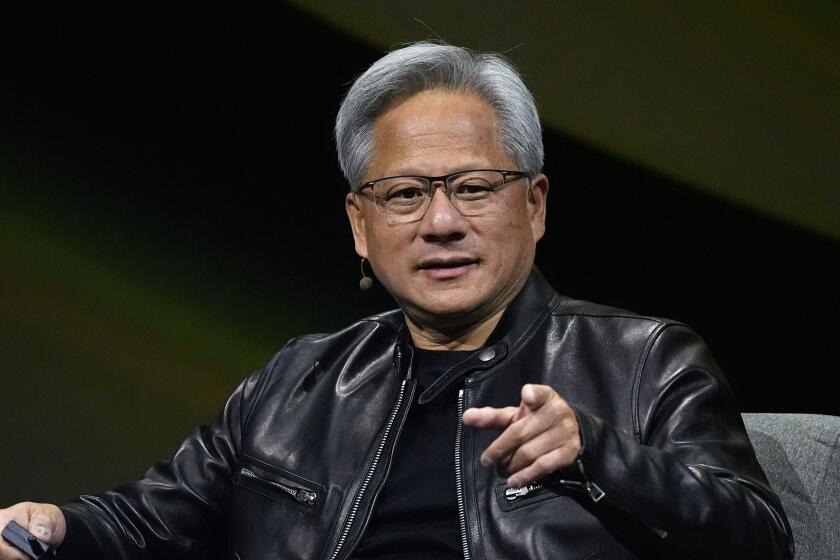Boeing auctioning equipment as it closes C-17 plant in Long Beach
Once there were so many workers building military cargo jets at Boeing’s sprawling plant in Long Beach that employees put flags on their cars to find them in the vast parking lot.
Now the parking lot is nearly empty. There are no “going out of business” signs posted out front, but this month the company is holding its first auction of the plant’s mammoth equipment.
For the record:
6:50 p.m. Nov. 7, 2018This article says Douglas Aircraft Co. built a C-17 factory in Long Beach in the late 1980s before becoming McDonnell Douglas Corp. The company was already McDonnell Douglas at that time, and it expanded an existing building to create the factory.
The 25-acre factory that assembled 279 of the workhorse C-17 air haulers is being disassembled.
Workers are putting the final touches on the last eight planes, but already four of the five manufacturing bays sit nearly silent.
During production, employees wore earplugs because of the clattering racket. Now birds sing from the rafters.
“The first time I heard the birds, it was a reality check,” said Tiffany Pitts, a Boeing Co. spokeswoman who took The Times to see the equipment being auctioned off.
“Boeing is not going away in California,” Pitts added, “but that doesn’t change the sad fact that this plant is closing down.”
The plant’s closure is a painful loss for Long Beach’s economy and the end of an era in which Southern California’s aerospace industry, and its high-paying factory jobs, helped build a strong middle class.
The C-17 is the last major military or civilian aircraft to be assembled in California — although there is hope for the future.
Just 20 miles north, upstart SpaceX is building rockets, engines and spacecraft in Hawthorne for a fast-growing list of government and commercial customers. Virgin Galactic recently announced that it would build its new satellite-launching rocket in Long Beach. The Pentagon continues to buy drones built in Southern California. And the state could win a big chunk of the work on a new stealth bomber the Pentagon has planned.
Michael Conway, Long Beach’s economic development director, said officials are working with Boeing as the company decides what to do with the site, which years ago employed as many as 6,000 workers.
“It’s been like a big brother to the city,” Conway said of the plant. “It’s a very sad event.”
The Long Beach plant was built in the late 1980s by Douglas Aircraft Co., which won the Air Force contract to build the C-17 Globemaster III. Douglas then became McDonnell Douglas Corp. In late 1996, Boeing announced that it was purchasing its longtime rival.
The factory is part of what was once an immense aircraft manufacturing complex dating to World War II. Tens of thousands of people worked in the facility’s hangars, building planes like the MD-80 jetliner, the Boeing 717 and earlier, during the war, the B-17 bomber.
Those other hangars were shut down long ago. Boeing sold much of the site in 2012 to Sares-Regis Group of Irvine. Sares-Regis has been leasing parcels to companies including Mercedes-Benz, which recently built a large facility there.
The wide-bellied C-17 can carry 80 tons of troops and supplies. Equipment as large as the Army’s M-1 Abrams tank can roll through its rear door.
The four-engine cargo hauler can take off and land in remote regions that lack modern runways. It is frequently used on disaster relief and medical evacuation missions.
With wars in Afghanistan and Iraq, the Pentagon has flown the C-17 more than it planned.
The Air Force bought 223 of the planes, the last delivered in 2013. In recent years, Boeing has sold several dozen more to foreign militaries, but not enough to continue production. The company announced in September 2013 that it would close the line.
In a report last fall, Richard Aboulafia, an aerospace analyst with Teal Group, wrote that the Air Force could find in a few years that it needs more C-17s but it has no production line.
“When the Air Force began C-17 procurement,” Aboulafia explained in an email, “it hadn’t intended to fight two wars on the other side of the planet.”
Ed Gulick, an Air Force spokesman, said no C-17 is expected to be retired until the 2040s.
He said the Air Force was working with Boeing to identify equipment and tools in the plant that are needed to sustain and repair the fleet over the next decades. A 2012 contract allows the government to pay up to $500 million to Boeing for the equipment, parts and data needed to keep the air haulers flying.
Boeing hired an auction firm to collect bids on two dozen of the plant’s machines and tools. Included is the elephantine equipment making up the fuselage assembly line, which built the planes at a clip of up to 16 a year, according to the auction catalog.
Another for-sale item: a Gemcor Drivmatic fastening machine that drills and installs rivets with a force of 50,000 pounds and then shaves the top so the rivet is flush with the wing’s skin. The robot installs rivets at a rate of six to nine a minute.
Also on the block is an automated wing spar assembly tool that uses electromagnetic energy to install fasteners. In addition, two industrial vacuum systems, two Siemens control centers and various spare parts are for sale.
The auction firm, Heritage Global Partners of San Diego, said it had received interest from around the world.
David Barkoff, the firm’s sales director, called the auction “a phenomenal opportunity” for aerospace, maritime, automotive and other manufacturers to buy tools that are in “great condition.”
The auction by sealed bidding closes June 23.
On a tour of the closed sections of the plant in late May, much of the machinery was roped off with yellow “Caution” tape.
Signs posted near some machines read, “Production Complete. Do not enter.” A faint smell of grease and metal lingered in the air.
Boeing was Southern California’s largest private employer at one time. But the aerospace giant has cut its California workforce every year since 2001, according to its records.
At the beginning of the year, Boeing had 17,566 employees in the Golden State — half of the 35,000 employed here 10 years ago.
The company has been moving operations to states with lower taxes and labor costs, including South Carolina, Alabama and Oklahoma.
So far this year, Boeing has reported the expected layoffs of 739 California workers to the state.
Those layoffs included 397 in Long Beach and an additional 189 in El Segundo, where Boeing builds satellites. The company reported 153 layoffs in Huntington Beach, where its programs include a Phantom Works research team that focuses on secret “black budget” projects for the Pentagon.
In a statement, Boeing said that often workers receiving those layoff notices are reassigned or take voluntary retirement. The layoffs, the company said, were necessary to manage costs and increase productivity. It blamed caps on Pentagon spending required by automatic budget cuts known as sequestration.
Boeing announced last year that it was moving 1,000 engineering positions in its commercial aircraft division to Seal Beach and Long Beach, which has helped offset some of the California reductions. The company said it was “committed to preserving as much of our skilled California workforce as possible.”
Randy Sossaman, president of United Auto Workers Local 148, said there are now fewer than 400 union members working at the C-17 plant. Over the last year, Boeing has been issuing layoff notices about every two weeks, Sossaman said. Each time, he said, 25 to 70 people have been let go.
Many of the workers have retired. Boeing says some have found positions elsewhere in the company, although Sossaman said the firm is not currently offering such transfers.
Boeing’s C-17 program manager, Nan Bouchard, said production on the last C-17 should be complete before year’s end.
Executives don’t know what they will do with the factory, Bouchard said. There are no plans to build another plane or anything else there.
Boeing, she said, may put the site up for sale.
Twitter: @melodypetersen
ALSO:
Elon Musk’s growing empire is fueled by $4.9 billion in government subsidies
Looking to steer Latinos into auto design
More to Read
Inside the business of entertainment
The Wide Shot brings you news, analysis and insights on everything from streaming wars to production — and what it all means for the future.
You may occasionally receive promotional content from the Los Angeles Times.











